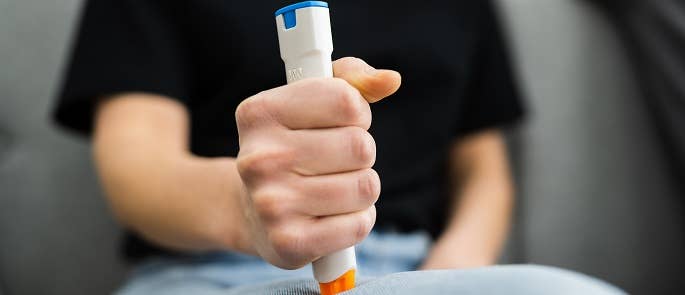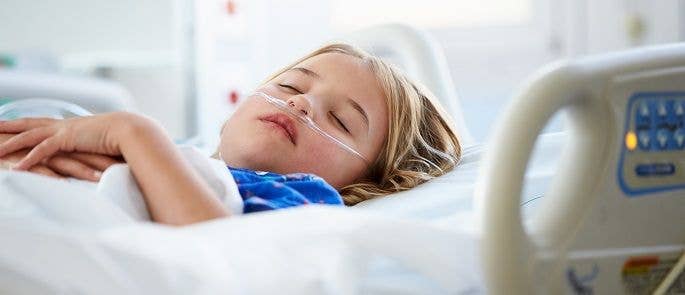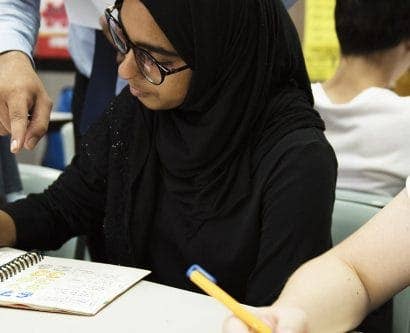What is an Individual Healthcare Plan?
It can be distressing for parents and guardians of children with ongoing medical conditions to send them off to school, particularly if they require regular medication or are at high risk of suffering a medical emergency. They must feel able to trust the staff, and the school’s systems and processes to keep their child safe.
Under the Children and Families Act 2014, schools have a responsibility to support pupils with medical conditions when they’re at school. Having an Individual Healthcare Plan (IHP) in place for these children means schools know exactly how to support their medical, educational, social and emotional needs, allowing them to participate as fully as possible in school, whilst remaining safe.
In this article, we will explain what IHPs are and how they can be used to support children with medical conditions in schools, who would benefit from an IHP and what information they should include. We will also provide you with a free, downloadable Individual Healthcare Plan template that can be adapted for use.

What is an Individual Healthcare Plan?
An Individual Healthcare Plan, also known as an IHP or IHCP, is a plan drawn up for children with ongoing medical conditions that details the support they may need in school, in order for their condition to be managed correctly and safely.
IHPs help to make sure that children are both safe and included in school by giving staff detailed information and guidance on how to provide support for their needs – primarily medical needs relating to their condition – but equally any educational, social or emotional needs that might stem from it.
An IHP sets out exactly what support is needed, how it should be given, when and by whom. This means that everyone knows their responsibilities for keeping the child as safe as possible in school, including, most importantly, in the event of a medical emergency.

An Individual Healthcare Plan is not the same as an Education, Health and Care (EHC) plan, which sets out the support required by children with special educational needs. However, some children will have both an IHP and an EHC plan. Unlike an EHC plan, an IHP does not rely on a formal statutory process, meaning an IHP can be drawn up as soon as it’s identified that a child has an appropriate medical need and can be reviewed at any time.
It’s essential that anyone with permission to access a child’s IHP is able to find, understand and use it quickly and efficiently. Anyone who may need to become involved in an emergency situation involving the child should have permission to access their IHP.
This may include:
- Teachers.
- Headteacher.
- School nurses.
- Lunchtime staff, including monitors.
- Safeguarding officers.
- Pastoral Staff.
- Teaching assistants.
- Extra curricular staff.
Only those with permission should be able to access an IHP, otherwise it must be kept confidential. Any decision to share an IHP must be made in collaboration between the school’s headteacher and the child’s parent or guardian, as well as the child themselves where appropriate.
Who Should be Involved in Writing an IHP?
An Individual Healthcare Plan must be a collaborative effort, with different voices representing the child and providing insight into how their condition can affect various aspects of their life.
It should be written in collaboration between:
- The child’s school – a representative from the child’s school could be anyone who is involved in providing support for them at school. This may be a teacher, general teaching assistant, 1:1 teaching assistant, SEN assistant and/or pastoral care staff. These individuals can provide insight into how the child’s condition impacts their education.
- The child’s parents or carers – of those involved in developing the IHP, parents/carers will often have the greatest understanding and experience of the child’s condition, outside of the child themselves, including how it affects them in everyday life. They will have experience of providing daily care and managing the child’s condition at home, making them best placed to know what kind of similar support the child will need in school. Take a look at our article on effective communication with parents in education, here.
- The child – this is appropriate if the child fully understands what is being discussed. If a child is over 14, it is generally advised that they are involved in the drawing up of their own IHP as they are nearing adulthood, when they will become responsible for their own welfare. The child should be as involved as possible in discussions relating to the support they need, sharing their views and what matters most to them.
- Healthcare professional/s – this is someone who provides medical care and support for the child and may include their GP, hospital consultants, physical therapists, etc. They can provide guidance on the specific medical support a child will require, including treatments and/or medications. They can also advise on any training staff members will need to provide this support safely, including in the event of an emergency.
This is not an exhaustive list of the individuals that can be involved in drawing up or reviewing an IHP. Other representatives may be part of the process depending on the child, their condition and their needs.

The collaborative nature of writing and reviewing an IHP has additional safeguarding benefits, as it allows different agencies to come together and get a full insight into that child’s day-to-day life. This means that any concerns about the child should be identified and reported quickly. You can read our article on creating a safeguarding culture in schools, here.
Who Needs an IHP?
Any child with an ongoing medical condition that affects their health and wellbeing and may require medication or treatment at school should be considered for an Individual Healthcare Plan. If their condition is severe and/or they have complex medical needs, it’s strongly advised that they have one drawn up, particularly if they are at high risk of a medical emergency.
However, there are no specific guidelines for what kind of health condition a child must have for them to need an IHP and, while a parent or guardian can request that their child has one drawn up, it is ultimately up to the child’s school to decide whether or not they receive one.
Some of the most common conditions that would necessitate a child to have an IHP include, but are not limited to:
- Diabetes.
- Epilepsy.
- Asthma.
- Allergies.
- Continence issues.
Every child will cope differently with their condition, requiring varying levels of care and support. Some ongoing medical conditions will pose less risk to a child than others and may not require complex care. Some children may be willing and able to administer their own medication or treatment for their condition.
In these cases, an IHP may not be necessary for that child, however, other children with the same condition may still need one. Different children will cope differently with the same condition, requiring different levels of care and support. For this reason, schools must consider each individual case carefully when deciding whether or not to draw up an IHP.
Ideally, the decision whether an IHP is necessary for a child should be a collaborative one between their school, their parent/guardian and their healthcare representative. However, if all parties cannot agree, the decision should rest with the headteacher.

How Can an IHP Support a Child With Allergies?
20% of serious allergic reactions to food involving children happen when they are at school. Having a serious food allergy puts children at risk of anaphylaxis, an emergency situation that requires a specific medical response – injection with an adrenaline auto-injector (AAI).
If a child has a serious food allergy, they may benefit from having an IHP in place, as school staff need to know exactly how to respond, without delay, if an allergic reaction occurs. If staff don’t know how to provide the correct support for a child during an allergic reaction, the outcome can be fatal.
If a child suffers from an allergic reaction at school and, for any reason, their own AAI can’t be used on them without delay, staff are not permitted to use another child’s AAI on them. To combat this problem, under changes to the Human Medicines (Amendment) Regulations 2017, schools can now buy back-up AAIs without a prescription.
Back-up AAIs may be used on children experiencing anaphylaxis. However, schools need to have written permission from the child’s parents and their medical care provider before they can use a spare AAI in an emergency. This permission can be written into that child’s IHP, so that if an emergency situation arises, it can be dealt with immediately. This exemplifies just one way an IHP can protect a child with allergies in school.
An IHP should also outline the training school staff need to be able to spot the signs of and manage allergic reactions effectively, as well as any triggers for that particular child and ways to reduce the risk of allergic reactions happening at all, also known as allergen avoidance.

The Benedict Blythe Foundation works to safeguard children with allergies in schools and support them to achieve their learning potential. They launched a campaign called Protect Pupils With Allergies that seeks to turn some of the current recommendations around keeping children with allergies safe in schools into legislation, meaning schools must implement them.
One of these recommendations is for every child with an allergy to have an IHP and anaphylaxis action plan completed and regularly updated, in collaboration between the child, their parent/guardian and the school. An anaphylaxis action plan functions as an emergency care plan for a child with allergies.
Other recommendations include having an allergy policy in place, having spare, in-date AAIs and implementing staff training on allergies and anaphylaxis in a whole school allergy awareness approach. You can learn more about the campaign and offer support, here.
Looking to Learn More?
Our Food Allergen Awareness Training Course teaches food handlers, including school caterers, about food hypersensitivities – including allergens, how to be compliant with the UK’s allergen laws and how to label and communicate allergen information properly in order to keep people with allergies safe.
What Information Should an IHP Include?
An IHP should be a clear, unambiguous description of a child’s health condition/s, how it affects them and the support they will need at school to help them overcome any barriers that would prevent them from having the same opportunities and experiences as other children, as far as possible.
There are no set guidelines for what an IHP must include and it’s ultimately up to the school how they decide to set one out and what to include in it, depending on each individual child and their requirements.
How detailed an IHP is will depend on the complexity and severity of their condition and support required. However, an effective IHP should include at least the sections listed below.
Personal Details
This includes the child’s:
- Name.
- Date of birth.
- Year and class group details.
- Photograph, if possible, so staff can recognise them.
- Medical condition/s and triggers/symptoms that can affect them.
- A clear outline of what to do in an emergency.
There also needs to be contact details for the child’s parent/guardian, their GP and any other relevant healthcare providers – such as a clinician or consultant – or essential contacts.
Medical Support Requirements
This section should include any daily medication and/or treatment requirements that must be administered at school, including:
- The name of the medication.
- Dose and frequency of administration
- Storage requirements
- Clear guidance on how to administer medication.
- The expiry date.
- How often medication or equipment should be checked and by whom – this is to make sure medication is still in date and not close to running out.
- Side effects to the medications, along with any other medications or treatments the child has outside of school and their possible side effects.
- Any self-administered medications or treatments, with the name of the person responsible for supervising self-administration and how they are expected to supervise.

Staff Responsibilities
This section should include a list of who has responsibility for providing support for the child at school. Everyone listed here should have access to and have read the IHP and be aware of their exact responsibilities concerning the child’s care.
It must also list the training that each staff member requires to fulfil their responsibilities, as well as any training they already have, when it was completed and when this training is valid until. A named individual, documented within the plan, should be responsible for ensuring staff receive their necessary training and keep a record of this information.
Need a Course?
Take a look at our range of CPD certified Teaching and Education Courses, including Epilepsy Awareness Training, Anaphylaxis Awareness Training and Paediatric First Aid Training.
The Child’s Views
Children should be encouraged to be as involved in developing their IHP as possible, where appropriate. They should be allowed to offer insight into how their condition affects them at school; physically, socially and emotionally and will be able to provide insight into areas they feel they need support in and others they perhaps don’t. It is also helpful to consider whether or not the child feels comfortable sharing their condition with their classmates, or whether they would prefer for this to be as confidential as possible.
These views should be considered while writing the rest of the plan. You can find guidance on encouraging children to express their feelings and emotions in our article, here.
Emergency Response
This is a vital section of the IHP as it outlines exactly what staff must do in the event of a medical emergency. This should address:
- What constitutes an emergency situation?
- What are the signs and symptoms of an emergency?
- What can trigger an emergency?
- Who is responsible in an emergency?
- What action/s should be taken by responsible staff members if an emergency occurs?
- Should any follow up actions be taken after an emergency situation to support the child? You can learn about how to support individuals who have received first aid assistance in our article, here.
- When should an ambulance be called?
By answering these questions, responsible staff know exactly how to respond if an emergency arises and can act without delay, reducing the risk to the child.
In this section, it is important to have appropriate and significant information to hand if an ambulance is required. This way, an effective medical response can be obtained quickly as possible, without having to search for essential information. An example of this is included in the Individual Healthcare Plan template at the end of this article.

Daily Support Requirements
Here you should detail any regular support the child may need at school to ensure their condition doesn’t prevent them having the same opportunities as others and to keep them safe. This is where input from the different parties involved in a child’s care is particularly important.
You should include:
- Dietary support – is there anything the child may need to eat and drink as part of the treatment of their condition, as well as any food or drinks they should not consume? You may indicate here if the child needs to eat at a certain time of day or needs assistance eating or drinking.
- Educational support – consider how the child’s condition affects their ability to learn in school and outside of it. For example, does it impact their behaviour and/or concentration and could any adjustments be made to support their learning experiences in light of this? For example, they might require extra lessons or additional breaks.
- Attendance support – having an ongoing medical condition can affect a child’s attendance and in turn their ability to fully engage in school. What can be done to support the child if their attendance is affected, what might they need while they’re away to make sure they keep up, or upon returning to be able to catch up?
- Activities support – outline any additional support the child may need to take part in certain activities at school, particularly physical activity. For example, if they need more time to get between lessons, need extra toilet breaks or would benefit from using the disabled toilets. Think about if any other factors might affect how well they can engage in activities, such as weather or location.

- SEN support – detail here any SEN support the child may need in addition to their medical support. Think about whether their SEN may affect or be affected by their condition.
- Social support – think about how the child’s condition could affect their ability to engage socially in school, particularly if they need to take a lot of time off school. Remember that adult involvement in social situations changes the nature of socialising between children and young adults, so they need opportunities to socialise with other children without an adult present.
- Emotional support – consider what kind of emotional challenges might be expected for the child because of their condition and any strategies they have in place, or that could be implemented, to help them deal with this. This might include counselling.
- Any other support requirements – outline any support you feel would help the child to be fully involved in school that hasn’t already been mentioned.
You can learn more about supporting social, emotional and mental health in pupils in our article, here.
Extra Curricular Arrangements
You must detail any additional support required for school activities that take place outside of the school or outside of regular timetabling. For example, school trips – particularly overnight trips – sports clubs or matches and after-school clubs.
The IHP should state who is primarily responsible for providing medical care in these situations, should the child need it, including in the case of an emergency. Again, these people must have read and understood the IHP and their responsibilities and have sufficient training to provide care.

Review and Consent
The plan should conclude with details of the annual review date, including any known reasons why the plan may need to be updated sooner than this.
However, it’s important to remember that when a child has an ongoing medical condition, their needs can change at any time, without warning, so a plan can be reviewed at any time before the annual date.
Anyone permitted to make changes to the IHP, as well as the sections they are allowed to change, should be listed here, too.
Finally, the plan must be signed by:
- The child or young person.
- Their parents/guardians.
- The school representative.
- The healthcare representative.
This is to verify that they have consented to the plan and the programme of support laid out in it.
Individual Healthcare Plan Template
The following template includes all of the essential sections we have just discussed. However, every child and their situation is unique so, should you decide that a particular child would benefit from additional support that isn’t outlined in this template, you should include this in your plan.
You can download our free individual healthcare plan template, here:
Children should be able to take part in school life without worrying about their medical condition. They, and their parents or guardians, must be assured that they are in an environment where they’ll always receive any support they need, quickly and correctly. Having an IHP is vital for achieving this and is something you should consider implementing for any child in your school with an ongoing medical condition.
Further Resources:
- How to Support Children With Speech, Language and Communication Needs
- How to Create a Positive Learning Environment
- Introduction to Safeguarding Children Training Course (Level 1 Safeguarding)











